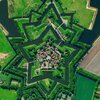T
Tania Admin
I have a huge interest in Old/Ancient buildings and history and thought it would be cool to have a thread where we can all share Old/Ancient buildings/structures that perk our interest.
I am starting with one that isn't commonly talked about.
Citadel of Erbil-Kurdistan - World Heritage List
The site of the citadel may have been occupied as early as the Neolithic period, as pottery fragments dating to that period have been found on the slopes of the mound. Clear evidence for occupation comes from the Chalcolithic period, with sherds resembling pottery of the Ubaid and Uruk periods in the Jazira and southeastern Turkey, respectively. Given this evidence for early occupation, the citadel has been called the oldest continuously occupied site in the world.
Human settlement at Erbil can be dated back to the 5th millennium BC, and it is one of the oldest continuously inhabited areas in the world. The earliest historical reference to the region dates to the Third Dynasty of Ur of Sumer, when King Shulgi mentioned the city of Urbilum. The city was later conquered by the Assyrians

I am starting with one that isn't commonly talked about.
Citadel of Erbil-Kurdistan - World Heritage List
The site of the citadel may have been occupied as early as the Neolithic period, as pottery fragments dating to that period have been found on the slopes of the mound. Clear evidence for occupation comes from the Chalcolithic period, with sherds resembling pottery of the Ubaid and Uruk periods in the Jazira and southeastern Turkey, respectively. Given this evidence for early occupation, the citadel has been called the oldest continuously occupied site in the world.
Human settlement at Erbil can be dated back to the 5th millennium BC, and it is one of the oldest continuously inhabited areas in the world. The earliest historical reference to the region dates to the Third Dynasty of Ur of Sumer, when King Shulgi mentioned the city of Urbilum. The city was later conquered by the Assyrians































